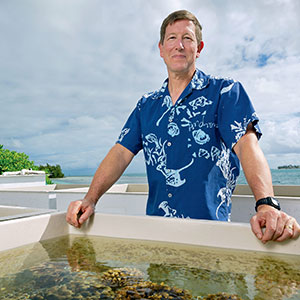
As carbon dioxide emissions have increased in the atmosphere, the ocean has absorbed a greater amount of carbon according to a publication co-authored by University of Hawaiʻi at Mānoa oceanography Professor Christopher Sabine and selected as a 2021 Outstanding Scientific Paper by NOAA’s Oceanic and Atmospheric Research.
The study, published in Science, reported that the world’s oceans absorbed 34 billion metric tons of carbon from human activity between 1994 and 2007—a four-fold increase to 2.6 billion metric tons per year when compared to the average uptake for the period starting from the Industrial Revolution in 1800 to 1994.
Despite this increase, the percentage of emissions—about 31%—absorbed by the ocean has remained relatively stable when compared to the first survey of carbon in the global ocean published by Sabine and co-authors in 2004.

“The uptake and storage in the ocean of human-produced carbon dioxide has significantly decreased the climate change effects the planet has seen so far,” said Sabine, who is also the interim vice provost for research and scholarship. “Getting a handle on how much more the ocean can take before marine ecosystems are severely compromised is critical for predicting future climate change impacts.”
By absorbing carbon dioxide from the atmosphere, the ocean reduces the warming impact these emissions would have had if the carbon dioxide had remained in the atmosphere. However, carbon dissolved into the ocean causes seawater to acidify, threatening the ability of shellfish and corals to build their skeletons, and affecting the health of other fish and marine species—many that are important to Hawaiian coastal economies and food security.
Sabine’s publication and the two others selected in Weather and Climate categories, were chosen as exemplary scientific endeavors that showcase the effective collaboration of federal, contractor and cooperative institute scientists to produce research that is vital in advancing NOAA’s mission to better understand the natural world and help protect its precious resources.
This research is an example of UH Mānoa’s goal of Excellence in Research: Advancing the Research and Creative Work Enterprise (PDF) and Building a Sustainable and Resilient Campus Environment: Within the Global Sustainability and Climate Resilience Movement (PDF), two of four goals identified in the 2015–25 Strategic Plan (PDF), updated in December 2020.
For more information, see School of Ocean and Earth Science and Technology’s website.
–By Marcie Grabowski

